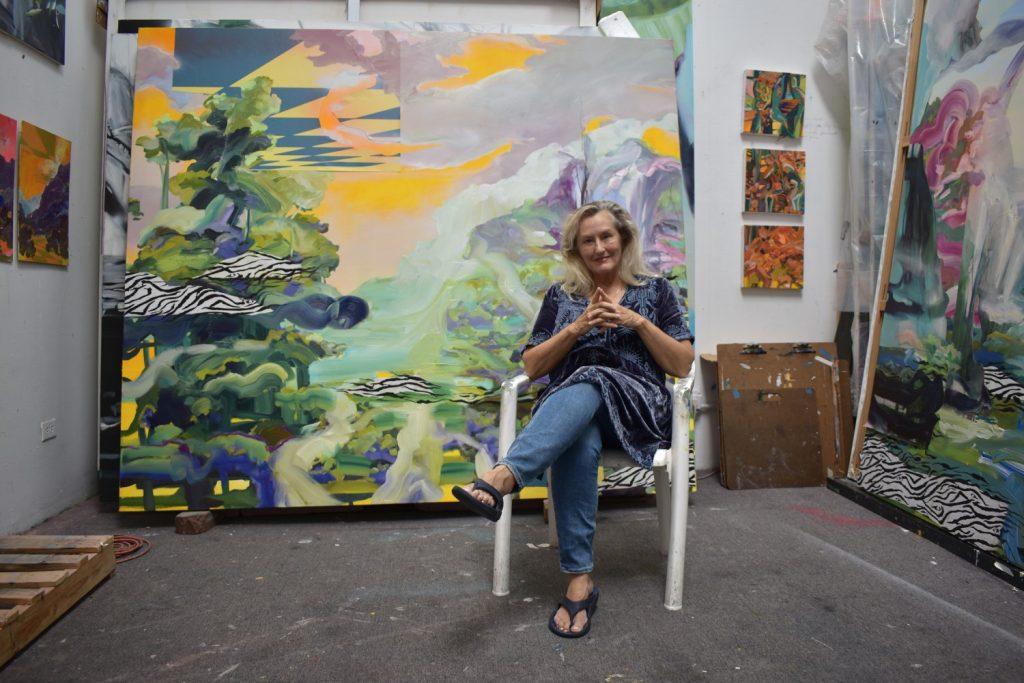Pepperdine Art Professor Yvette Gellis takes a break in an on-campus art studio. Gellis said art has been a lifelong passion of hers. Photo by Mary Elisabeth
Art Professor Yvette Gellis was born and raised in Chicago and born and raised with art. During her childhood, she said she went on constant trips with her mother who was also an art teacher, to see “Paris Street; Rainy Day” by Gustave Caillebotte at the Art Institute of Chicago.
Almost 15 years out of graduate school and well into her professional art career, Gellis said she still meditates before she starts every one of her abstract watercolor paintings. After a long and successful career, with art shows and galleries around the world, she said teaching came naturally to her, and she has always been drawn to creative work through God and her faith.
“When you think of the arts, it’s like a higher form of expression, but in everything you do, you don’t have to talk about it or even share it with the world,” Gellis said. “It’s like a secret garden inside yourself. I tell my students that I carry around within me a portable paradise, so no matter where I go, I always have it there.”
Gellis has been teaching at Pepperdine since 2014, and said she teaches Observational Drawing, Explorations in Drawing, and Painting.
Gellis said she wants viewers of her art to feel like they can not only just walk into the painting but step into the world she has created. She paints inspired by nature and the world around her.
One of her favorite pieces she has completed is the large 7-by-7 foot painting “Ascension” from 2021, which features three earth-toned human figures, dancing and existing in a sky full of clouds, she said.
She has also done large murals for the public in Santa Monica, a fabric display taking up a whole city block at NYU and exhibits that feature a sculpture on the outside, so the painting can exist beyond the canvas and become interactive.
Her student and mentee, senior Art major Hayden Araza, said she worked with Gellis at her studio at 18th Street Arts Center in Santa Monica, helping her build canvases, cataloging and more. After being encouraged to create art in that studio, Araza said it was “a powerful experience” to fully immerse herself in the flow of an artist’s lifestyle.
“She creates these installations that you can feel like you’re stepping into these worlds that she’s creating these moments of time that are just being captured,” Araza said. “I honestly think it’s truly beautiful.”
What is the main inspiration for your art? What do you find yourself having the desire to paint?
“During COVID, my work moved out of these architectural renderings and abstraction and my plane with different environments to the figure. My figures became non-gendered, and they were not specific in color. They were just figures. They could be man, woman and any color. That was just before COVID, where I had a switch to nature, more directly to leaves, and the leaves became the branches of trees — to the roots to the interconnectivity of all trees and then cities, countries under the oceans, you know, the whole world being connected.”
You have some very large scale paintings, how long do those take you and do you prefer working on this larger scale?
“I spend 10 times longer on small works than I do big works. Because some people paint from their fingers, some people paint from their elbow, I work from the shoulder. I’m a shoulder artist. So, the main ideas I can block in a week, like a series of three paintings, I can block these in a week. Then, I’ll go back into them, and probably right now, they are about 75 to 80% finished, and maybe I’ll add another layer of firm down any collage work that needs to be set. Knowing when to quit is a big deal for me.”
Do you have any advice for young, up-and-coming artists?
“Don’t try to follow what everybody else is doing. Really listen to your own voice. That’s why it’s so important to meditate. Do what you want to do. What is important is getting to know who you are and getting to know your soul. When you start to discover who you are, then you’ll know what kind of work to do and then it’s really fun.”
You mentioned meditation and faith a lot at the start of the interview, how do these play a role in your art and process?
“I never, never, start working unless I meditate. It’s so important to calm your body and get rid of all the stress and the anxiety. I do teach meditation in my classes and kind of whatever aspect of God that appeals to someone. You know, make it personal. For me, I will sit down and meditate, and there are times I feel so much the power and love of God that I cry when I’m working — because I feel the presence and sometimes I look at the work, and I don’t even know where it came from. Somebody else did it.”
____________________
Follow the Graphic on Twitter: @PeppGraphic
Email Beth Gonzales: beth.gonzales@pepperdine.edu


